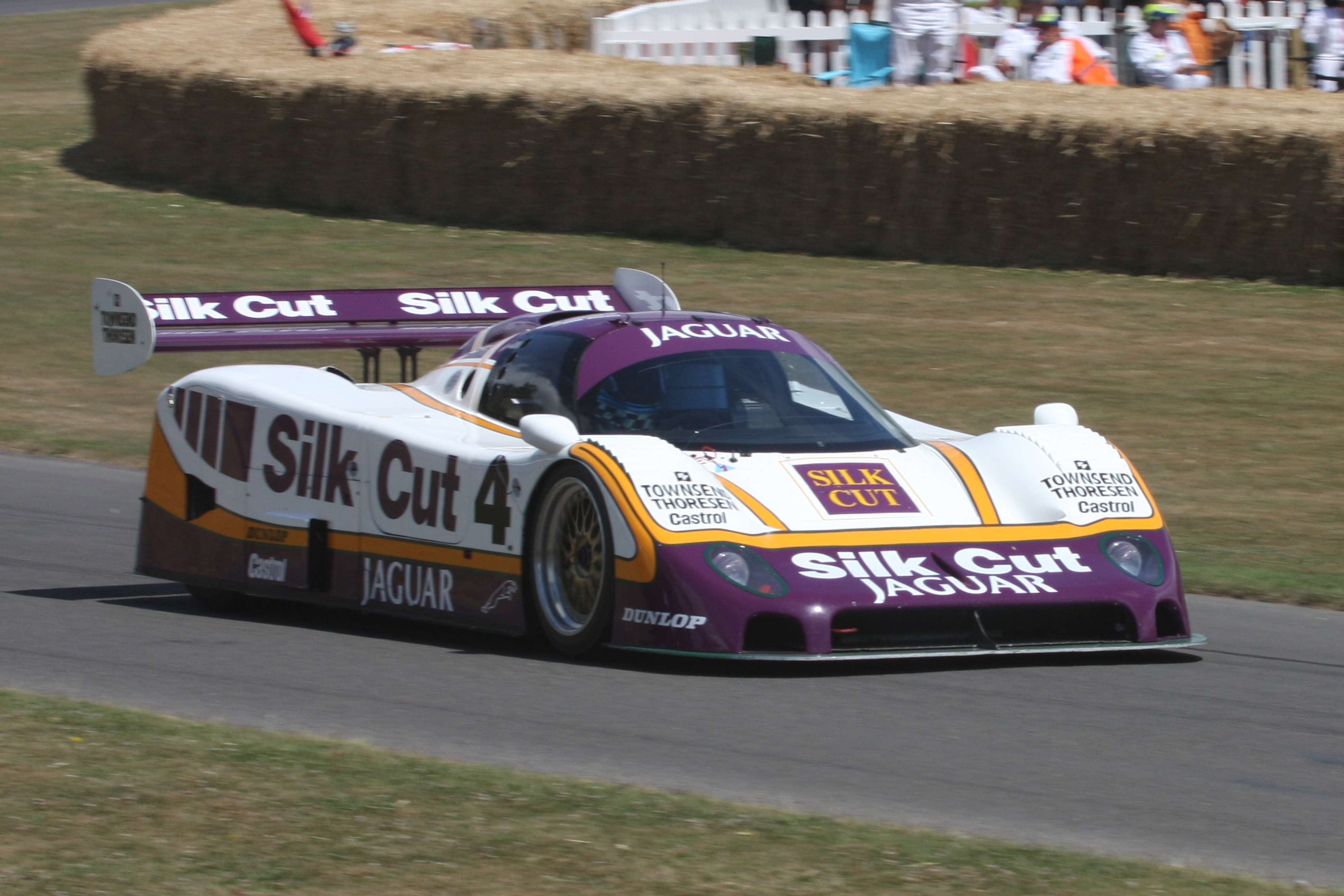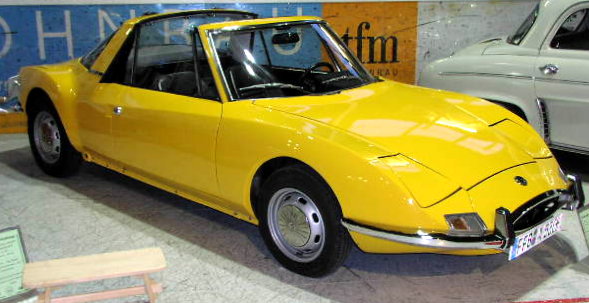|
Matra-Simca MS680
The Matra MS680 (sometimes referred to as Matra-Simca MS680) is a sports prototype racing car made by the French manufacturer Matra, which raced in the 1974 World Sportscar Championship, 1974 World Sports Prototype Championship and the 1974 24 Hours of Le Mans. Description The MS680 was the last sports car developed by Matra. The only MS680 made was based on a modified chassis of the Matra MS670, MS670C. Powering the car was the Matra Sports V12 engine, Matra V12 engine. The MS680 was used in the first pre-race tests and in the race at the 1974 24 Hours of Le Mans. The car was driven by Jean-Pierre Beltoise and Jean-Pierre Jarier. During the race Matra suffered from engine overheating problems, causing the car to break down after 104 laps of the race. Matra retired from international motor racing in late 1974 and the car was no longer used. The only example of MS680 is kept inside the Matra Museum in Romorantin-Lanthenay. References {{Matra car timeline Matra vehicles ... [...More Info...] [...Related Items...] OR: [Wikipedia] [Google] [Baidu] |
Sports Prototype
A sports prototype, sometimes referred to as simply a prototype, is a type of race car that is used in the highest-level categories of sports car racing. These purpose-built racing cars, unlike street-legal and production-based racing cars, are not intended for consumer purchase or production beyond that required to compete and win races. Prototype racing cars have competed in sports car racing since before World War II, but became the top echelon of sports cars in the 1960s as they began to replace homologated sports cars. Current ACO regulations allow most sports car series to use two forms of cars: grand tourers (GT), based on street cars, and prototypes, which are allowed a great amount of flexibility within set rule parameters. In historic racing, they are often called "sports racing cars". Sometimes, they are incorrectly referred to as "Le Mans cars", whether they are competing in the Le Mans race or not. Types of sports prototypes Since the 1960s, various championship ... [...More Info...] [...Related Items...] OR: [Wikipedia] [Google] [Baidu] |
Racing Car
Auto racing (also known as car racing, motor racing, or automobile racing) is a motorsport involving the racing of automobiles for competition. Auto racing has existed since the invention of the automobile. Races of various sorts were organised, with the first recorded as early as 1867. Many of the earliest events were effectively reliability trials, aimed at proving these new machines were a practical mode of transport, but soon became an important way for automobile makers to demonstrate their machines. By the 1930s, specialist racing cars had developed. There are now numerous different categories, each with different rules and regulations. History The first prearranged match race of two self-powered road vehicles over a prescribed route occurred at 4:30 A.M. on August 30, 1867, between Ashton-under-Lyne and Old Trafford, a distance of eight miles. It was won by the carriage of Isaac Watt Boulton. Internal combustion auto racing events began soon after the construc ... [...More Info...] [...Related Items...] OR: [Wikipedia] [Google] [Baidu] |
Matra
Matra (an acronym for Mécanique Aviation Traction) was a French industrial conglomerate. During its years of operation, it was engaged in a wide range of business activities, primarily focused around automobiles, bicycles, aeronautics and weaponry. Following the acquisition of vehicle manufacturer Automobiles René Bonnet, the company formed Matra Automobiles during the 1960s and made the Matra brand famous through the production of a range of racing cars and sports cars. Its car division worked closely with other vehicle manufacturers, most significantly Renault, prior to the decline and sale of Matra Automobiles during the early 2000s. In addition to road cars, Matra entered into a wide range of businesses, eventually diversifying into media, weaponry, aeronautics, automobiles, and music distribution. Matra was at one point owned by the Floirat family. Throughout much of the company's existence, French businessman Jean-Luc Lagardère served as the CEO of Matra. During 1 ... [...More Info...] [...Related Items...] OR: [Wikipedia] [Google] [Baidu] |
1974 World Sportscar Championship
The 1974 World Sportscar Championship season was the 22nd season of FIA World Sportscar Championship motor racing. It featured the 1974 World Championship for Makes 1974 FIA International Championships, 1975 FIA Yearbook, grey section, pages 89 & 90 and FIA Cup for GT Cars which were contested concurrently over a ten race series from 25 April to 9 November 1974. The World Championship for Makes, which was open to Group 5 Sports Cars and Group 4 GT Cars,Peter Higham, The Guinness Guide to International Motor Racing, 1995, page 259 was won by Equipe Matra Sports, Matra and the FIA Cup for GT Cars by Porsche. Schedule The 1974 World Championship for Makes and FIA Cup for GT Cars were contested concurrently over a ten race series. Results Races World Championship for Makes Points were awarded to the top 10 finishers in the order of 20-15-12-10-8-6-4-3-2-1.Peter Higham, The Guinness Guide to International Motor Racing, 1995, page 260 Makes were only awarded the applicable p ... [...More Info...] [...Related Items...] OR: [Wikipedia] [Google] [Baidu] |
1974 24 Hours Of Le Mans
The 1974 24 Hours of Le Mans was the 42nd Grand Prix of Endurance, and took place on 15 and 16 June 1974. It was the fifth round of the 1974 World Championship for Makes. After Alfa Romeo had won the first race of the season at Monza, it had been Matra all the way and they came to Le Mans as firm favourites for a third consecutive outright victory, especially after Alfa Romeo withdrew its cars just before raceweek. In a fairly lacklustre race, the Matra of Henri Pescarolo and Gérard Larrousse led virtually from start to finish for their second successive victory.Laban 2001, p.173-4 It was also the third in a row for Pescarolo and the Matra team. The race was enlivened on Sunday morning when the leading car was delayed for a long time by engine and gearbox troubles. But such was the lead they had built up that they were not headed. Second place, six laps back was the works-supported Martini Porsche 911 turbo of Gijs van Lennep and Herbert Müller while third went to another Matra ... [...More Info...] [...Related Items...] OR: [Wikipedia] [Google] [Baidu] |
Matra MS680B
Matra (an acronym for Mécanique Aviation Traction) was a French industrial conglomerate. During its years of operation, it was engaged in a wide range of business activities, primarily focused around automobiles, bicycles, aeronautics and weaponry. Following the acquisition of vehicle manufacturer Automobiles René Bonnet, the company formed Matra Automobiles during the 1960s and made the Matra brand famous through the production of a range of racing cars and sports cars. Its car division worked closely with other vehicle manufacturers, most significantly Renault, prior to the decline and sale of Matra Automobiles during the early 2000s. In addition to road cars, Matra entered into a wide range of businesses, eventually diversifying into media, weaponry, aeronautics, automobiles, and music distribution. Matra was at one point owned by the Floirat family. Throughout much of the company's existence, French businessman Jean-Luc Lagardère served as the CEO of Matra. During 1988, ... [...More Info...] [...Related Items...] OR: [Wikipedia] [Google] [Baidu] |
Matra Sports V12 Engine
The Matra Sports V12 engine is an automotive internal combustion engine for sports car endurance racing and Formula One. It won the 24 Hours of Le Mans three times. Characteristics The Matra Sports V12 is a four-stroke, water-cooled all-aluminum 60° double overhead camshaft V12 engine with a seven-main-bearing crankshaft. It produced between , and of torque. History This engine was designed by engineer Georges Martin, who designed the Simca " Poissy engine". Martin joined Matra at the end of 1966 due to Philippe Guédon (who later became CEO of Matra), his former colleague at Simca without knowing what was expected of him. Jean-Luc Lagardère announced that it is responsible to design an engine for Formula One Formula One (also known as Formula 1 or F1) is the highest class of international racing for open-wheel single-seater formula racing cars sanctioned by the Fédération Internationale de l'Automobile (FIA). The World Drivers' Championship ... which has ... [...More Info...] [...Related Items...] OR: [Wikipedia] [Google] [Baidu] |
Matra Vehicles
Matra (an acronym for Mécanique Aviation Traction) was a French industrial conglomerate. During its years of operation, it was engaged in a wide range of business activities, primarily focused around automobiles, bicycles, aeronautics and weaponry. Following the acquisition of vehicle manufacturer Automobiles René Bonnet, the company formed Matra Automobiles during the 1960s and made the Matra brand famous through the production of a range of racing cars and sports cars. Its car division worked closely with other vehicle manufacturers, most significantly Renault, prior to the decline and sale of Matra Automobiles during the early 2000s. In addition to road cars, Matra entered into a wide range of businesses, eventually diversifying into media, weaponry, aeronautics, automobiles, and music distribution. Matra was at one point owned by the Floirat family. Throughout much of the company's existence, French businessman Jean-Luc Lagardère served as the CEO of Matra. During 1988, ... [...More Info...] [...Related Items...] OR: [Wikipedia] [Google] [Baidu] |
Sports Prototypes
A sports prototype, sometimes referred to as simply a prototype, is a type of race car that is used in the highest-level categories of sports car racing. These purpose-built racing cars, unlike street-legal and production-based racing cars, are not intended for consumer purchase or production beyond that required to compete and win races. Prototype racing cars have competed in sports car racing since before World War II, but became the top echelon of sports cars in the 1960s as they began to replace homologated sports cars. Current ACO regulations allow most sports car series to use two forms of cars: grand tourers (GT), based on street cars, and prototypes, which are allowed a great amount of flexibility within set rule parameters. In historic racing, they are often called "sports racing cars". Sometimes, they are incorrectly referred to as "Le Mans cars", whether they are competing in the Le Mans race or not. Types of sports prototypes Since the 1960s, various championships ... [...More Info...] [...Related Items...] OR: [Wikipedia] [Google] [Baidu] |
24 Hours Of Le Mans Race Cars
4 (four) is a number, numeral and digit. It is the natural number following 3 and preceding 5. It is the smallest semiprime and composite number, and is considered unlucky in many East Asian cultures. In mathematics Four is the smallest composite number, its proper divisors being and . Four is the sum and product of two with itself: 2 + 2 = 4 = 2 x 2, the only number b such that a + a = b = a x a, which also makes four the smallest squared prime number p^. In Knuth's up-arrow notation, , and so forth, for any number of up arrows. By consequence, four is the only square one more than a prime number, specifically three. The sum of the first four prime numbers two + three + five + seven is the only sum of four consecutive prime numbers that yields an odd prime number, seventeen, which is the fourth super-prime. Four lies between the first proper pair of twin primes, three and five, which are the first two Fermat primes, like seventeen, which is the third. On the ... [...More Info...] [...Related Items...] OR: [Wikipedia] [Google] [Baidu] |


_1st.jpg)







